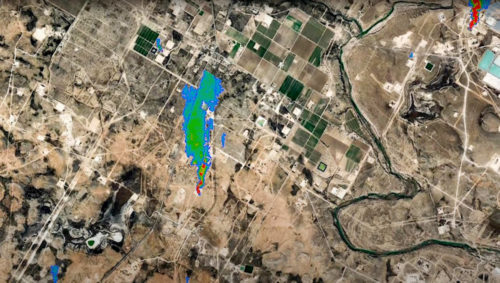Screenshot

How Monitoring Methane Can Help Countries Deliver Emissions Reductions
Methane was a focal point during the COP26 climate conference, and for good reason. This potent greenhouse gas has 120 times the climate-warming power of CO2 as soon as it is emitted. This fact has been largely been ignored—until now.
A series of pledges announced at COP are finally taking aim at methane. World leaders from 109 countries pledged to reduce global methane emissions 30 percent by 2030 as part of the Global Methane Pledge. The United States rolled out a Methane Action Plan and proposed new rules to tackle methane emissions from oil and gas infrastructure. And an agreement between the United States and China included pledges to cut methane pollution.
Pledges are a critical first step, but now begins the hard work to translate these pledges into action. The good news is we don’t need to wait to get to work. Governments and businesses can start now by leveraging and expanding emerging measurement and monitoring programs to help reevaluate methane emissions baselines, guide mitigation, track and report their emissions, and hold themselves and each other accountable.
Why Monitoring Matters
Historically, measurement of methane emissions has not happened at the scale, speed, or frequency required by the urgency of the climate crisis. You can’t manage what you don’t measure—and precise, sustained visibility and awareness of superemitters across all sources at the country, state, community, and facility levels is key to driving focused actions to reduce emissions.
To make the invisible visible—and therefore actionable—a growing ecosystem of public and private actors are creating a complementary constellation of satellites and data platforms that together can deliver direct, continuous, transparent, and global greenhouse gas monitoring.
The Space Race to Save the Climate
Several of these actors (MethaneSAT, Carbon Mapper, GHGSat, and Kayrros) participated in a panel discussion at COP26 to discuss the growing wave of methane-detecting satellites. Each of these systems has its own distinct capabilities and purposes, which fit together in a broader, systematic approach to monitoring.
“There is no swiss army knife for emissions monitoring because the sources we must track are so different. We need different observing systems to see the whole elephant,” said Riley Duren, CEO of Carbon Mapper, an initiative in which RMI is a partner. “In addition to satellites, we are always going to need ground-based measurements, airborne measurements, and different techniques. What is most exciting is that the systems today are giving us a level of insight that we can act on now.”
RMI is developing an insight brief and interactive web tool to help policymakers understand what information is currently available, and where gaps still exist.
Translating Data into Action
With just over eight years left in this decisive decade, time is running short to meet emissions reduction targets. Beyond deployment of operational monitoring systems like Carbon Mapper, there is a critical need to accelerate the translation of advanced methane data into action. Existing and emerging success stories should instill confidence among leaders at upcoming COPs that data completeness and transparency can yield meaningful emissions reductions and a positive climate impact.
The California Air Resources Board is using data from NASA and Carbon Mapper aerial surveys, with voluntary participation by facility operators, to successfully reduce methane emissions from superemitting landfills, oil and gas fields, and natural gas infrastructure across the state.
Additionally, RMI and other organizations are using emissions data to differentiate oil and gas based on its emissions intensity. MiQ, created by RMI and Systemiq, is an independent certification that differentiates producers based on their methane emissions performance and incentivizes businesses to improve because it makes good climate—and business—sense. MiQ is in the process of certifying methane emissions from 10 percent of all US oil and gas, and increased pickup by oil and gas companies that operate globally are helping to align markets with the goals of the Global Methane Pledge. Broader adoption across global value chains is sure to accelerate as monitoring programs like Carbon Mapper come online.
Going Beyond the Tip of the Iceberg
Yet these examples are just the tip of the iceberg.
“Beyond motivated actors like the State of California, there are still many high-emitting jurisdictions and businesses that have yet to come forward with mitigation commitments, and/or may not know this data is available,” Duren said. “We must educate them that these tools are available and help them understand and translate the data to action.”
This is true for the “shovel-ready” sectors like oil and gas, where there are known solutions to curbing methane. But it is also true for tougher sectors like agriculture or waste management, which are more difficult to mitigate but will become easier as visibility improves.
In short, governments and businesses have an opportunity to act now on methane, aided by new measurement and monitoring capabilities. Decision makers can leverage these efforts to help guide and verify the actions needed to significantly reduce methane emissions in the near term—a necessary step to finally address this potent greenhouse gas and help avoid the worst impacts of climate change.